How is your summer going? Ours is busy, although we have been able to enjoy the fruits of our labor along with a Sunday stroll along the shore, (we are privileged living on the East Coast, despite the winters). It may be hot, but summer brings its own inspiration: seasonal fruits, sunsets, and back at the warehouse, batches of freshly made paper. As we count the paper we enjoy the varying colors and textures, like a fun fish pattern, a luscious lokta in parrot green, and a cooling slate blue hanji.
Speaking of TEXTURE, we’d like to introduce our Artist of the Month for August; Bill Lorton, who does wonderful work with the art of joomchi, incorporating hanji to create these intriguing combinations of color and texture.
PCI: What kind of artwork do you do?
BL: I consider all of the work I make to be fiber through and through. My BFA is in Fiber and my MFA in Textiles, so regardless of what process or concept is at play it (nearly) always boils down to an investigation of materiality. Weaving has always been a large component of my studio practice, and over the past 6 years, joomchi (Korean paper fusing) has gained an equally prominent role. The weavings are part of larger compositions that form impotent machines, while the joomchi work is concerned with decay and mending. The woven work and the Joomchi haven’t crossed paths conceptually, and I’m okay with that…although it can get a little difficult having to switch thought processes so frequently.
PCI: What or who has influenced/inspired you?
BL: The general environment I grew up in has had a profound and lasting impact on the work I make, as well as the way I work. My first eighteen years were spent in a very rural part of Illinois. I was close to nature daily, and I think that has largely dictated my material sensibilities. Domestic crafts were a ceaseless presence as well, so I couldn’t help but learn to make things in those terms…which absolutely determined my decision to pursue a career as a Fiber/Textile artist.
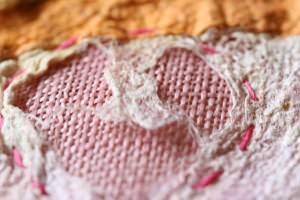
PCI: What attracts you to working with paper?
BL: Initially, I simply needed paper to make joomchi. Since then I’ve developed a more acute interest in the enormous variety of material characteristics that are available. Also, it’s a bit alchemical…forming a sheet of paper is like magic to me, even though I completely understand the science behind it.
PCI: What do you like best about working with paper? Have you ever made paper? Hands down, the transformative potential of paper is the best thing about it. It can become nearly anything. I’ve made paper a few times, although I consider myself far from competent. I had the great pleasure of making paper at The Morgan with both Aimee Lee and Velma Bolyard. It was tons of fun, and I can’t wait to do it again.
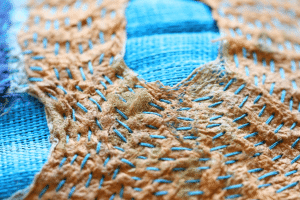
PCI: How did you hear about Paper Connection?
BL: I heard about Paper Connection International from Aimee Lee. I was so happy to finally have a source for hanji!
PCI: And we are so happy about that-thanks Aimee! Did you have much knowledge about Japanese or other Asian papers before using our papers?
BL: I really didn’t know much about paper types.
PCI: In what ways did Paper Connection help guide and educate you about Japanese, Korean, and other Asian papers?
BL: I had to place a large order to cover my 2014 Joomchi workshops. To fill my quantity needs (and keep my costs down) Paper Connection set me up with several “close-outs”. Just the variety of hand-made Japanese unryu papers was stunning, I feel like I gained a better understanding of what constitutes a “good” paper.
PCI: What papers do you use of ours and for what process?
BL: The hanji is my favorite…I could roll around in that stuff all day. The hand-made Japanese unryu papers are fantastic too. I use them both for joomchi.
PCI: That would be fun. What did you like about those papers that aided in your creative and/or technical process?

BL: Having a variety of papers on hand is essential for the joomchi work I make. Each paper behaves a little differently, so it’s good to be able to adjust according to my conceptual needs.
PCI: What are some of the differences between our papers and others you have worked with?
BL: Paper Connection’s hanji doesn’t deteriorate as quickly as others I’ve used for joomchi. That’s a good thing when I’m looking for a particular surface finish.
PCI: Fill in the blank, if you had to recommend a Paper Connection paper for a particular application…?
BL: Any of the heavier hand-made unryu papers should be tried in a joomchi application. The difference between these and the tissue-weight stuff one might pick up at the local art supply store is dramatic. Paper Connection’s heavier unryu stock makes for a beefier, denser piece…and it can handle much more abuse.
PCI: And rolling around! Thank you so much, Bill. We really appreciate your time!
For more on Mr. Lorton, please visit his blog: Bill Lorton Blogspot
We received this beautiful joomchi sample made by Bill; sent via the Morgan. We love it! Thank you!
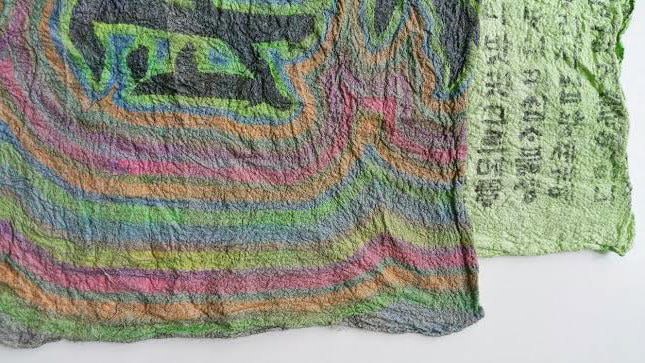

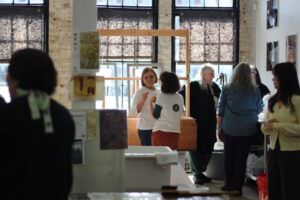
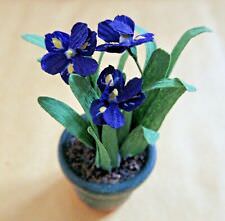
2 comments
Sharron
I bought mulberry paper and it disintegrates and runs how and where do you pick the right paper. Should it be thick? Mine isn’t it is like tissue paper. I didn’t pay much for it. But I was experimenting.
Paper Woman
Hi Sharron,
Thanks so much for your very good question!
There are so many kinds and qualities of papers. If you plan on doing “joomchi” as described in the blog here, then you need to use long-fibered paper, such as paper made out of “kozo” or “”dak”-high quality mulberry fiber. We recommend our dyed “hanji”, used over and over again for this purpose. Please check out this link: http://shop.paperconnection.com/collections/hanji-papers
Best,
Paper Woman